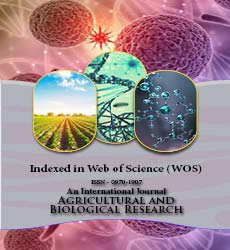Agricultural and Biological Research
RNI # 24/103/2012-R1
Nuru Seid Tehulie*, Fikru Mekonnen, Agegnehu Mekonnen, Ahmed Hassen, Semira Ebrahim and Solomon Abebe
Enhancing the production and adaptability of grain cereals involves a key goal of realize the genetic complexity of individuality. One effective way to discover genetic areas in the research population that co-segregate in the trait of interest is through bi-parental Quantitative Trait Loci (QTL) linkage mapping. But utilizing a Genome-Wide Association Study (GWAS) to map Linkage Disequilibrium (LD) has recently emerged as a way for determining the molecular genetic base of phenotypic diversity that occurs naturally. The power of this method has allowed the recognition of numerous contributory allele(s)/loci that were not found in QTL mapping populations. GWAS has been effectively utilized to identify the contributory allele or loci in barley (Hordeum vulgare L.) that can be employed in the breeding crop to improve yield and adaptability. This exciting method has clearly shown to be a useful tool in the recognition of candidate genes and represents a significant improvement in genetic analysis. This review first outlines the recently employed method for genetic analysis (association mapping or linkage mapping), next it presents the fundamental statistical and genetic ideas of GWAS and last it highlights the genetic discovering made possible by GWAS. The review described how cutting-edge bioinformatics techniques can be used to identify the candidate gene or genes. Overall, the year, population structure and trait all affected the accuracy of GS; high accuracy suggests that these growths and yield related traits can be selected in molecular breeding using GS. Through marker-assisted selection and GS in breeding programs, the SNP markers found in various studies can be used to enhance yield and growth and yield related attributes. When used in barley breeding, GS has produced observable genetic gains.
